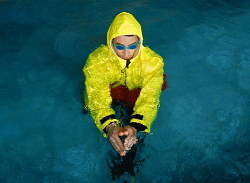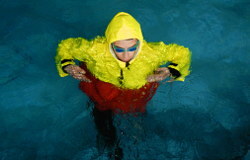Warm-up and Stretching
A well-designed water workout includes three simple ingredients: warm-up, exercise, and warm-down.
The warm-up and warm-down should always sandwich the exercise phase, preparing your body to work in the water and then get ready to return to land. The exercise phase is where you focus on desired outcome.
Before and after your training session do some easy exercise. This can be push-ups, pull-ups, sit-ups, squats, or flutter kicks, and water exercises such as pool sprints, treading water, swimming with fins, and a variety of other lifeguard and overall water comfort exercises. Our warm up exercises loosen and warm up your muscles, and thus reduce the risk of injury.
Wrong Stretching Routine
In the morning you decide to go out for a little lifesaving fitness swim. You put on all your lifeguard swimming kit, head for the pool, and do your usual two-minute stretching routine. You prop a foot up and bend forward to stretch your hamstring, then you straighten up for a calf stretch. You jump up and down a couple of times to get your blood moving, then into the pool you go.
Completely wrong, say scientists who have studied the effects of stretching for many years.
Some stretching routines may not help but hinder your athletic performance.
Turns out a spate of new research reveals that much of what we've long believed to be beneficial
about proper stretching techniques may have the opposite effect.
Controversy about Methods
You may have been told that flexibility is important for increased performance ability and to decrease the occurrence of injury. But is it? While you should never base all your decisions on one report, it may be more important to stretch at the right time, or it might be a waste of time. What is the difference between flexibility, stretching and warming up?
No Stretching
Studies like those in "The Physician and Sportsmedicine" show that
stretching before exercise does not decrease the risk of injury,
and that increased warm-up is probably more valuable.
Warm-up - Workout - Stretching
Others say wait until after your workout because stretching decreases
the muscle's ability to generate force for some period of time after the stretch has been performed;
you will be slower after you stretch, until your muscle recovers.
To gain flexibility, stretching must be performed after the muscle has been fully warmed up
and is already at its greatest current level of flexibility, most likely after a workout has been completed.
Warm-up - Stretching - Workout
Still others say you should warm-up, stretch, then get back in and swim some more laps.
Their line of reasoning is that stretching before a workout only returns a muscle to its normal level of exercise flexibility.
may decrease your strength, power, and performance.
Avoid Static Stretching and Bouncing
Static stretching significantly reduces your power, recent research has found. The ballistic stretches (the kind we were warned not to do in gym class as kids, where you bounce during the stretch) also cause a decrease in power, but slightly less so than the static stretches.
To improve your range of motion and avoid injury, you need to stretch,
but you should never stretch a cold muscle in any way.
Doing static stretches where you hold the stretch before a workout or competition,
Stretching During Swim Events
During a swim meet, limit stretching before your event to a few seconds to help you relax after you complete an in-pool, pre-event warm-up. Finish with additional stretching after completing your workout as part of your cool-down routine.
After warm-up and stretching wear a anorak or cycling cape while waiting around on poolside or in the warm-up pool. This keeps you warm and supple.
No warm-up pool?
Then do some other gentle activity to increase blood circulation and raise the temperature of your muscles.
Do a slight, gentle stretching, then get up and swim fast!
Begin your Warm-up in the Pool
Warming up increases blood flow, which increases the temperature in the muscle, which makes the collagen fibres more elastic like a rubber band. Do this before and after your workout session to relax your muscles.
Always start with some mild aerobic warm-ups to get more blood to the tissue before doing any stretching. Warm-up should begin with an in-pool aerobic session, followed by 5 minute stretching on the pool deck, some in shallow water and some in deep water.
Warm-ups should begin with an in-pool aerobic session, followed by 5 minute stretching on the pool deck, some in shallow water and some in deep water.
- Do a few simple exercises on pool side
- Go for a short 10 to 15 minute swim session warm-up
- Do a brief 5 to 10 minute stretching session
- Get back into the pool for the rest of your workout
Dynamic Stretching
After warming up, do dynamic (not static) stretches. This means slow, controlled movements rather than remaining still and holding a stretch. Include simple movements like arm circles and hip rotations, flowing movements as in yoga, or walking or jogging exercises.
While studies have not clearly proven this, increasing numbers of experts agree that dynamic stretching is the best stretching routine before a workout or competition.
Proper technique is key. Poor technique that is not anatomically correct puts you at higher risk for injury.
Do several repetitions of 30 seconds each at your own pace.
The point is to do the movements in a controlled way.
Stop if you get tired so you still have energy for your workout.
Arm Exercises
This full length arm exercise builds upper body strength works mainly your biceps and triceps muscles, plus your shoulder and back muscles.
Stand in shoulder deep water, one foot forward, one back. Stretch your arms out sideways. Using a good amount of strength push your arms together and apart again, around a 90° angle. Return to the start position by flexing your triceps. Repeat.
Make a good effort, squeeze it in and push out hard. Keep going for at least a minute, preferably much more, until you really feel your muscles. Then take a short break before you continue with a variation of this.


Variation
Upper arm exercise works biceps and triceps. It is the same again, but you simply bend your arms at the elbows and pull your hands to the chest. Then push out again. Push hard against the resistance for the water. Keep going for a minute or more.


Cool Down Stretching
Follow-up with additional stretching after completing your swim as part of your cool-down routine. The cool down portion of your workout is an important moment to stretch your muscles. The best time to stretch is post-workout when our muscles are completely relaxed, thoroughly warmed up and capable of giving us the most stretch, easiest.
When muscles are really well warmed up they exhibit a high degree of plasticity. That means that not only do they stretch but after stretching and cooling down they maintain an increased range of movement and display greater flexibility.
After your workout or competition do static stretches. This is where you'll lengthen muscles and improve your flexibility. Doing static stretching before a workout and then nothing after is the most common mistake many make.
Take the time to stretch each muscle group that you exercised.
Hold static stretches for about 30 to 90 seconds.
Breathe deeply through the cool down period to help your muscles melt into the stretch.
You will find when you stretch during the cool down that you will feel less soreness from your workout.
Besides helping to prevent injuries,
this decrease in soreness is important for maintaining your motivation to adhere to your workout routine day in and day out.
New research shows it's a good move to learn stretching routines customized for your swimming and lifesaving sport and to help prevent the injuries most common to it.
Never stretch to the point of pain. Forget the phrase "no pain, no gain." Stretch to tightness, not to pain. You don't want pain when you're doing your stretching. It should be gentle to start and then progress.
When you do your static stretching after your session, you should go to the point of slight discomfort and intensity, to improve your flexibility. But if you're making a face, your muscle is contracting to protect itself, which is counterproductive.
To achieve and maintain the benefits of an aquatic exercise program,
follow the main principles of stretching.
- Do not bounce.
- Hold the stretch for 10-15 seconds.
- Stretch every muscle in your body from neck to calves.
- Start at the top of your body and work downward.
- Concentrate on your thighs, hamstrings, chest, back, and shoulders.
Follow-up with additional stretching after completing your swim as part of your cool-down routine.
Range of Movement
This is the reason why you should stretch.
Whether you are a lifeguard or survival swimmer,
your sport will need your muscles to perform by working through a range of movements.
When they are too tight and constricted, they tend to work against each other to perform the move.
That means that energy which should be used in the move itself
is actually soaked up by fighting against the muscles themselves and the supporting muscle groups.
This drains away your power.
Stretch to De-stress
In these stressed-out times stretching can help. As you know, your mind affects your body, and your body affects your mind.
During times of emotional stress, the muscles in your body contract. This is an adaptive response to acute stress, as it fortifies your "body armour" so that in times of danger, if you get hit, for example, your muscles help to protect you.
However, in times of chronic stress, these same mechanisms that have evolved to protect us can create problems.
Chronically tensed muscles, especially those in the back and neck, predispose to chronic pain or injury.
Thus, stress management techniques can help prevent this.
Also, gentle stretching of chronically tensed muscles provides relaxation to the mind as well as the body.
If you had a stressful day, put on your lifeguard kit and hop into the local pool just to do your de-stressing exercises,
then float in the pool until your mind has relaxed too.